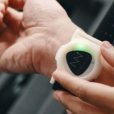Imagine that you find a suspicious package at the station and inform the police. Instead of putting personnel at risk, they send Argus, a robot equipped with backscatter X-ray technology. From a safe distance of 1,500 meters, Argus captures high-definition images, unveiling the package’s contents and potential dangers. This crucial information allows experts to strategize and neutralize the threat, keeping both the public and themselves out of harm’s way. Whew.
In a breakthrough for bomb detection technology, X-ray tech company Micro-X (ASX: MX1) has accomplished the first phase of field testing for its cutting-edge Argus X-ray Camera. This device promises to transform high-risk search operations and provide stand-off imaging capabilities for identifying and diagnosing improvised explosive devices (IEDs).
Conducted over several days in May within South Australia, the testing involved the utilisation of backscatter X-ray technology (a non-invasive imaging technique that uses scattered X-rays to create detailed images of objects and materials) to capture images simulating common scenarios faced by military and law enforcement bomb technicians.
Micro-X’s Chief Executive Officer, Kingsley Hall, said, “This field testing demonstrates two significant capabilities of Argus – the ability to remotely capture high-definition backscatter images through a solid barrier, together with the ability to capture a high-definition image of a shallow-buried ordnance. We are extremely excited by the way that Argus performed in these realistic scenarios.
“Looking ahead, we are confident that Argus can not only transform how the bomb tech community images suspect packages and explosives, but that there is an even wider application to the military, especially clearing large areas of buried explosive hazards such as land mines. We look forward to putting our product in the hands of customers.”
During the testing phase, Argus successfully captured clear and valuable high-definition backscatter images of an IED concealed behind a vehicle door. Additionally, it was able to obtain backscatter images of a shallow-buried landmine. The robust communication system of Argus enabled remote image acquisition from a stand-off distance of 1,500 meters, outperforming previous-generation backscatter systems by a significant margin.
Argus produces high-definition backscatter images that can improve the speed and accuracy of threat assessment, making it safer for bomb technicians, whether in the military or elsewhere. Additionally, It can remotely capture images of weapons buried close to the surface. This feature enables it to support large-scale military missions that involve finding and dealing with buried threats by identifying, accessing, and neutralising them.
Argus represents a revolutionary approach to stand-off detection and diagnosis of IEDs, conventional explosives, and improvised threats by utilizing backscatter X-ray technology. Micro-X’s patented “Pinhole Camera” technology plays a pivotal role in this innovation, as it illuminates the target with a cone-beam, capturing reflected X-rays through a pinhole array.
What sets Argus apart is its ability to capture backscatter X-ray images while stationary, eliminating the need for a separate imaging panel. Argus is better than legacy devices in that it produces clearer images with reduced noise and no blurring issues associated with movement. This advancement marks a significant leap forward in enhancing the effectiveness and safety of bomb detection operations.
- Ovanti’s iSentric signs contracts worth $14.4m with Malaysian commercial bank - June 27, 2024
- Baby Bunting fights back from retail downturn with 5-year strategy, includes Gen-Z focus and self-funded growth - June 27, 2024
- CLEO meets with US FDA to develop strategy for ovarian cancer test launch - June 26, 2024













Leave a Comment
You must be logged in to post a comment.